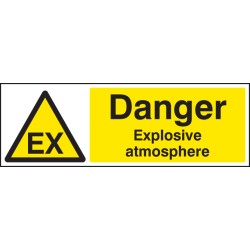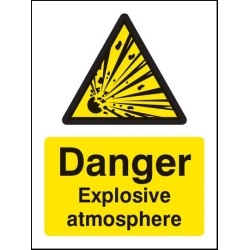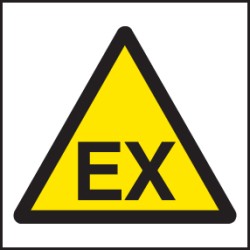Search
Products meeting the search criteria
Compressed Gas 2
A "Compressed Gas 2" sign is used to identify areas, containers, or cylinders that store compressed gases classified under hazard class 2, which includes gases under pressure such as oxygen, nitrogen, carbon dioxide, and others. This sign is important because it alerts workers, emergency responders,..
GHS Labels - Oxidiser
Using GHS Labels for Oxidisers is essential to ensure clear and consistent communication of chemical hazards across workplaces, transportation, and storage facilities. These labels help identify substances that can greatly increase the risk of fire or explosion by supplying oxygen to support combust..
GHS Labels - Flammable
Using GHS labels for flammable substances is vital for clearly communicating the fire risks associated with certain chemicals and materials. These labels alert workers, handlers, and emergency responders to the presence of substances that can easily catch fire, helping everyone take the necessary pr..
GHS Labels - Explosive
Using GHS Labels for Explosive Substances is essential for clearly identifying materials that pose a significant risk of explosion. These labels warn workers, handlers, transporters, and emergency responders about the potential danger of rapid chemical reactions that can cause blasts, fires, or proj..
GHS Labels - Toxic
Using GHS Labels for Toxic Substances is crucial for clearly communicating the health hazards posed by chemicals that can cause serious illness or death if ingested, inhaled, or absorbed through the skin. These labels alert workers, handlers, and emergency responders to the presence of toxic materia..
GHS Labels - Corrosive
Using GHS Labels for Corrosive Substances is essential for clearly identifying chemicals that can cause severe damage to skin, eyes, metals, and other materials. These labels warn workers, handlers, and emergency responders about the risks of chemical burns, tissue damage, and material corrosion, he..
GHS Labels - Compressed Gas
Using GHS Labels for Compressed Gas is crucial for clearly identifying containers and storage areas that hold gases under pressure. These labels warn workers, transporters, and emergency responders about the potential dangers such as explosions, rapid release of gas, or asphyxiation risks if the gas..
GHS Labels - Health Hazard
Using GHS Labels for Health Hazards is vital for clearly communicating the presence of substances that can cause serious health effects, such as respiratory issues, carcinogenicity, reproductive toxicity, or organ damage. These labels alert workers, handlers, and emergency responders to the potentia..
GHS Labels - Environmentally Hazardous
Using GHS Labels for Environmentally Hazardous Substances is crucial for identifying chemicals that pose a significant threat to the environment, particularly aquatic life. These labels alert workers, handlers, and emergency responders to the potential dangers that these substances can cause if rele..
GHS Labels - Irritant
Using GHS Labels for Irritant Substances is important for clearly identifying chemicals that can cause inflammation, redness, or discomfort to the skin, eyes, or respiratory system upon contact or exposure. These labels alert workers and handlers to the potential for mild to moderate irritation, hel..
LQ Diamond (ADR 2011)
The LQ Diamond (ADR 2011) is a specific label used in the transport of dangerous goods under the European Agreement concerning the International Carriage of Dangerous Goods by Road (ADR). LQ stands for Limited Quantity, which refers to the small amounts of hazardous materials that are exempt from so..
LQ Diamond Y - Air Transport (ADR 2011)
The LQ Diamond Y – Air Transport (ADR 2011) label is used to identify packages containing dangerous goods in limited quantities that are eligible for transport by air under specific regulations. The "LQ" stands for Limited Quantity, indicating that the hazardous material inside is in small enough am..
GHS Symbols
A GHS Symbol Warehouse Reminder Sign plays a vital role in maintaining safety in environments where chemicals are stored and handled. By prominently displaying the common Globally Harmonised System (GHS) hazard symbols, the sign helps warehouse workers quickly recognize the types of dangers present...
Toxic
UN regulations (including ADR, IATA and IMDG) stipulate that all dangerous goods must be clearly identified. Diamonds (other than those of class 7 radioactive status) and the insert of any text (other than UN class number) below the symbol is to be confined to particulars indicating the nature of th..
Corrosive
UN regulations (including ADR, IATA and IMDG) stipulate that all dangerous goods must be clearly identified. Diamonds (other than those of class 7 radioactive status) and the insert of any text (other than UN class number) below the symbol is to be confined to particulars indicating the nature of th..
Explosive
UN regulations (including ADR, IATA and IMDG) stipulate that all dangerous goods must be clearly identified. Diamonds (other than those of class 7 radioactive status) and the insert of any text (other than UN class number) below the symbol is to be confined to particulars indicating the nature of th..
Danger - Explosive Atmosphere
Hazard signs are displayed to advise and forewarn of potential dangers. Material Options Explained Below is a more detailed description of the materials this particular safety sign is available in. Helping you decide which sign option is most suitable for your application. 1. Rigid Plastic: Lightw..
Danger - Explosive Atmosphere BS5499
Hazard signs are displayed to advise and forewarn of potential dangers. Material Options Explained Below is a more detailed description of the materials this particular safety sign is available in. Helping you decide which sign option is most suitable for your application. 1. Rigid Plastic: Lightw..
EX Symbol
Hazard signs are displayed to advise and forewarn of potential dangers. Material Options Explained Below is a more detailed description of the materials this particular safety sign is available in. Helping you decide which sign option is most suitable for your application. 1. Rigid Plastic: Lightw..
Explosive Diamond
UN regulations (including ADR, IATA and IMDG) stipulate that all dangerous goods must be clearly identified. Diamonds (other than those of class 7 radioactive status) and the insert of any text (other than UN class number) below the symbol is to be confined to particulars indicating the nature of th..
1.4 Diamond
UN regulations (including ADR, IATA and IMDG) stipulate that all dangerous goods must be clearly identified. Diamonds (other than those of class 7 radioactive status) and the insert of any text (other than UN class number) below the symbol is to be confined to particulars indicating the nature of th..
Non-Flammable Compressed Gas 2
UN regulations (including ADR, IATA and IMDG) stipulate that all dangerous goods must be clearly identified. Diamonds (other than those of class 7 radioactive status) and the insert of any text (other than UN class number) below the symbol is to be confined to particulars indicating the nature of th..
Toxic Gas Diamond
UN regulations (including ADR, IATA and IMDG) stipulate that all dangerous goods must be clearly identified. Diamonds (other than those of class 7 radioactive status) and the insert of any text (other than UN class number) below the symbol is to be confined to particulars indicating the nature of th..
Infectious Substance Diamond
UN regulations (including ADR, IATA and IMDG) stipulate that all dangerous goods must be clearly identified. Diamonds (other than those of class 7 radioactive status) and the insert of any text (other than UN class number) below the symbol is to be confined to particulars indicating the nature of th..
Radioactive I Diamond
UN regulations (including ADR, IATA and IMDG) stipulate that all dangerous goods must be clearly identified. Diamonds (other than those of class 7 radioactive status) and the insert of any text (other than UN class number) below the symbol is to be confined to particulars indicating the nature of th..
Radioactive III Diamond
UN regulations (including ADR, IATA and IMDG) stipulate that all dangerous goods must be clearly identified. Diamonds (other than those of class 7 radioactive status) and the insert of any text (other than UN class number) below the symbol is to be confined to particulars indicating the nature of th..
Radioactive II Diamond
UN regulations (including ADR, IATA and IMDG) stipulate that all dangerous goods must be clearly identified. Diamonds (other than those of class 7 radioactive status) and the insert of any text (other than UN class number) below the symbol is to be confined to particulars indicating the nature of th..
Black / White Diamond
UN regulations (including ADR, IATA and IMDG) stipulate that all dangerous goods must be clearly identified. Diamonds (other than those of class 7 radioactive status) and the insert of any text (other than UN class number) below the symbol is to be confined to particulars indicating the nature of th..
Oxidising Agent Diamond
UN regulations (including ADR, IATA and IMDG) stipulate that all dangerous goods must be clearly identified. Diamonds (other than those of class 7 radioactive status) and the insert of any text (other than UN class number) below the symbol is to be confined to particulars indicating the nature of th..
Non Flammable Gas
UN regulations (including ADR, IATA and IMDG) stipulate that all dangerous goods must be clearly identified. Diamonds (other than those of class 7 radioactive status) and the insert of any text (other than UN class number) below the symbol is to be confined to particulars indicating the nature of th..






























